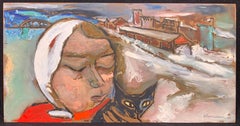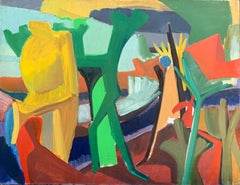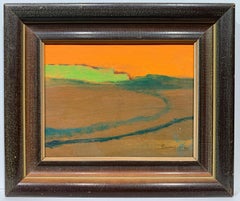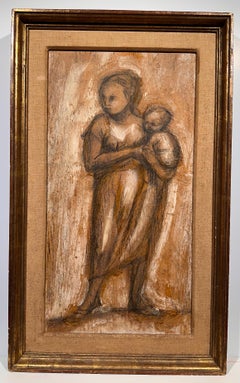Want more images or videos?
Request additional images or videos from the seller
1 of 7
Sterling Boyd StrauserYellow Caboose #2 (Lackawanna Railroad Freight Train Steam engine painting)1956
1956
Price:$850
$1,200List Price
About the Item
- Creator:Sterling Boyd Strauser (1907 - 1995, American)
- Creation Year:1956
- Dimensions:Height: 3.25 in (8.26 cm)Width: 24.5 in (62.23 cm)
- Medium:
- Movement & Style:
- Period:
- Condition:
- Gallery Location:Wilton Manors, FL
- Reference Number:1stDibs: LU24528217412
About the Seller
4.9
Platinum Seller
Premium sellers with a 4.7+ rating and 24-hour response times
Established in 2007
1stDibs seller since 2015
420 sales on 1stDibs
Typical response time: 2 hours
Authenticity Guarantee
In the unlikely event there’s an issue with an item’s authenticity, contact us within 1 year for a full refund. DetailsMoney-Back Guarantee
If your item is not as described, is damaged in transit, or does not arrive, contact us within 7 days for a full refund. Details24-Hour Cancellation
You have a 24-hour grace period in which to reconsider your purchase, with no questions asked.Vetted Professional Sellers
Our world-class sellers must adhere to strict standards for service and quality, maintaining the integrity of our listings.Price-Match Guarantee
If you find that a seller listed the same item for a lower price elsewhere, we’ll match it.Trusted Global Delivery
Our best-in-class carrier network provides specialized shipping options worldwide, including custom delivery.You May Also Like
'Pair of Perroquets', Large, Expressionist Oil, Parrots, Detroit Woman artist
Located in Santa Cruz, CA
Signed lower right, 'R. Hornak' for Rosemary Hornak (American, born 1951); additionally signed verso, titled 'Perroquets Impasto, Variation 2' and dated 1992.
Rosemary Hornak receiv...
Category
1990s Expressionist Animal Paintings
Materials
Masonite, Oil
$2,400
H 48 in W 32 in D 0.25 in
"Urban Renewal"
Located in Astoria, NY
Katherine S. Kirkman (American, XX-XXI), "Urban Renewal", Oil on Masonite, signed lower right, titled and signed to verso, wood frame. Image: 23.5" H x 19.5" W; frame: 26" H x 24" W....
Category
Late 20th Century Expressionist Landscape Paintings
Materials
Masonite, Oil
Small Expressionist Clown Portrait #2, 1960s
By Marjorie May Blake
Located in Soquel, CA
Small and colorful expressionist portrait of a clown by Marjorie Blake (American, 1920-1994). Signed "M. Blake" in the lower right corner. Dated "1969" ...
Category
1960s Expressionist Portrait Paintings
Materials
Masonite, Oil
"Gothic Window, " Acrylic on Masonite signed by David Barnett
By David Barnett
Located in Milwaukee, WI
"Gothic Window" is an original acrylic painting on masonite board by David Barnett. The artist signed the piece on the back. This painting depicts a geometric and abstracted renderin...
Category
1960s Expressionist Abstract Paintings
Materials
Masonite, Acrylic
$14,500
H 39 in W 33 in
Untitled by Enzio Wenk, 2017 - Acrylic Paint on Masonite, Expressionism
By Enzio Wenk
Located in Bresso, IT
Acrylic paint on masonite.
Category
2010s Expressionist Abstract Paintings
Materials
Masonite, Acrylic
$842
Free Shipping
H 19.69 in W 19.69 in
"Siamo in ogni cosa" by Enzio Wenk, 2010 - Oil Paint on Canvas, Expressionism
By Enzio Wenk
Located in Bresso, IT
Translated title: "We are in everything"
Oil paint on canvas.
It features a wooden frame and it can't be hung, since it is meant to lean against the wall.
Category
2010s Expressionist Figurative Paintings
Materials
Canvas, Oil, Wood
$2,227
H 78.75 in W 20.48 in D 1.19 in
Large Figurative French Expressionist Signed Oil, group of figures, Moses?
Located in Cirencester, Gloucestershire
Artist/ School: French School, indistinctly signed and dated
Title: Large group of figures travelling through desert - possibly Biblical, Moses?
Medium: signed oil painting on canvas, framed and inscribed verso.
framed: 24.25 x 20 inches...
Category
20th Century Expressionist Figurative Paintings
Materials
Canvas, Oil
$1,647
H 24.25 in W 20 in D 1 in
Mid Century French Expressionist Portrait of a Man, framed oil painting
Located in Cirencester, Gloucestershire
Artist/ School: French School, mid 20th century
Title: Expressionist portrait of a man
Medium: oil painting on board, framed
framed: 27.25 x 27.5 inches
canvas: 21.75 x 18 inc...
Category
Mid-20th Century Expressionist Portrait Paintings
Materials
Oil
$3,308
H 27.25 in W 27.5 in D 1 in
Mid 20th Century French Expressionist Oil Elegant Lady looking over Moonlit Lake
Located in Cirencester, Gloucestershire
Artist/ School: French School, circa 1950's
Title: an expressionist painting depicting an elegant lady overlooking a moonlit lake view.
Medium: oil on board, framed
Framed: 13 x...
Category
Mid-20th Century Expressionist Figurative Paintings
Materials
Oil
1950’s French Expressionist Oil Dusk Landscape House & Bare Trees
Located in Cirencester, Gloucestershire
The House amongst Trees
French Expressionist painter, mid 20th century
oil painting on canvas, unframed
painting: 10 x 13 inches
provenance: private collection, France
condition: o...
Category
Mid-20th Century Expressionist Abstract Paintings
Materials
Canvas, Oil
More From This Seller
View AllWinter Walk with Jasper, (Black Cat painting)
By Sterling Boyd Strauser
Located in Wilton Manors, FL
Sterling Strauser (1907-1995). Dorothy and Jasper, Crystal Street Station, 1970. Oil on masonite panel, 11.5 x 22.25 inches. Signed and dated lower right. Very good condition with no damage or conservation. Unframed. Framing services available.
Image depicts the artist's wife, Dorothy Strauser, walking the beloved family cat, Jasper. In the background can be seen the East Stroudsburg Pa Train Depot on Crystal Street.
Provenance: Estate of the artist's Granddaughter, Princeton NJ.
Often called a romantic expressionist and American intimist, self-taught Pennsylvania artist Sterling Strauser (1907-1995) completed his first oil painting in 1922- inspired by frequent visits to the collection of American folk art at the Everhardt Museum in Scranton. Throughout the following seven decades of his career, Strauser’s artistic pursuit was based on his own intuition and determination to paint what he saw, rather than adhering to the conventional pictorial structures prescribed by prevailing styles at the time. Strauser rejected pretension, believing instead that art should work from life as it was lived. His oeuvre therefore serves as an extremely personal record of his observations and experiences from his lifetime painting in East Stroudsburg, Pennsylvania.
Beginning early in his career, Strauser took his inspiration from American regionalists and traditional realists in the Ashcan style, as well as European movements such as Fauvism and Cubism, yet he eventually developed his own fluid realism based on subject matter beloved and familiar to him- family and friends, local landscapes and floral still lifes.
Known for his distorted pictorial space, exaggerated with vivid color, heavy impasto and an intensity of emotion, Strauser was adept at altering and rearranging the details and aspects of any given form to create a new kind of beauty.
"All a painting has to do, or a piece of sculpture, or whatever, is to entertain the critical eye. You have to have a fresh seeing eye… to look at things like a child, as if looking at the world for the first time (seeing) something that somebody else doesn’t see, something you want to identify with… Painting is largely a matter of evaluation. (It) doesn’t matter how much it looks like the subject matter. It just depends on how interesting you have made it so that it pleases the critical eye."
STERLING STRAUSER, STERLING STRAUSER: A MODERNIST REVISTED, P. 23
Sterling exhibited his work extensively throughout the country and drew the attention of many notable fellow artists including Milton Avery, Louise Nevelson, David Burliuk, Chaim Gross and Red Grooms. Sterling was also extremely influential within the arts community of Pennsylvania through his discovery and promotion of self-taught American Folk artists such as Justin McCarthy, Jack Savitsky, Joseph Gatto...
Category
Mid-20th Century Expressionist Landscape Paintings
Materials
Masonite, Oil
$1,800 Sale Price
55% Off
Abstract Figurative Expressionist painting
Located in Wilton Manors, FL
Amazing Figurative Expressionism painting with exceptional color and movement. Oil on canvas, ca. 1960s. Measures 40 x 52 inches. Unsigned and unattributed. Excellent condition.
Category
Mid-20th Century Expressionist Abstract Paintings
Materials
Oil
$975 Sale Price
35% Off
Landscape with Orange Sky
Located in Wilton Manors, FL
James Earl Ray (1928-1998). Landscape with Orange Sky. ca. 1975. Oil on masonite panel measures 6.5 x 8.5 inches, 10.5 x 12.5 inches framed. Signed lowe...
Category
Mid-20th Century Abstract Abstract Paintings
Materials
Masonite, Oil
$1,500 Sale Price
40% Off
Mother and Child
By Bruno Lucchesi
Located in Wilton Manors, FL
Bruno Lucchesi (b.1926). Mother and Child, ca. 1960. Oil and charcoal on sized paper mounted to masonite, measuring 11 x 21 inches; 15.5 x 25.5 inches in original gold leaf frame. Si...
Category
Mid-20th Century Abstract Figurative Paintings
Materials
Masonite, Paper, Oil
$560 Sale Price
20% Off
Untitled (ER41) Abstract Expressionist painting
Located in Wilton Manors, FL
Edward Pechmann Renouf (1906-1999). Oil on panel measures 16 x 24 inches. Signed lower margin. Excellent condition.
Provenance: Allan Stone Pr...
Category
1970s Abstract Expressionist Abstract Paintings
Materials
Masonite, Oil
$1,200 Sale Price
20% Off
Untitled (ER44) Abstract Expressionist painting
Located in Wilton Manors, FL
Edward Pechmann Renouf (1906-1999). Oil on panel measures 16 x 24 inches. Signed lower margin. Excellent condition.
Provenance: Allan Stone Pr...
Category
1970s Abstract Expressionist Abstract Paintings
Materials
Masonite, Oil
$1,200 Sale Price
20% Off



